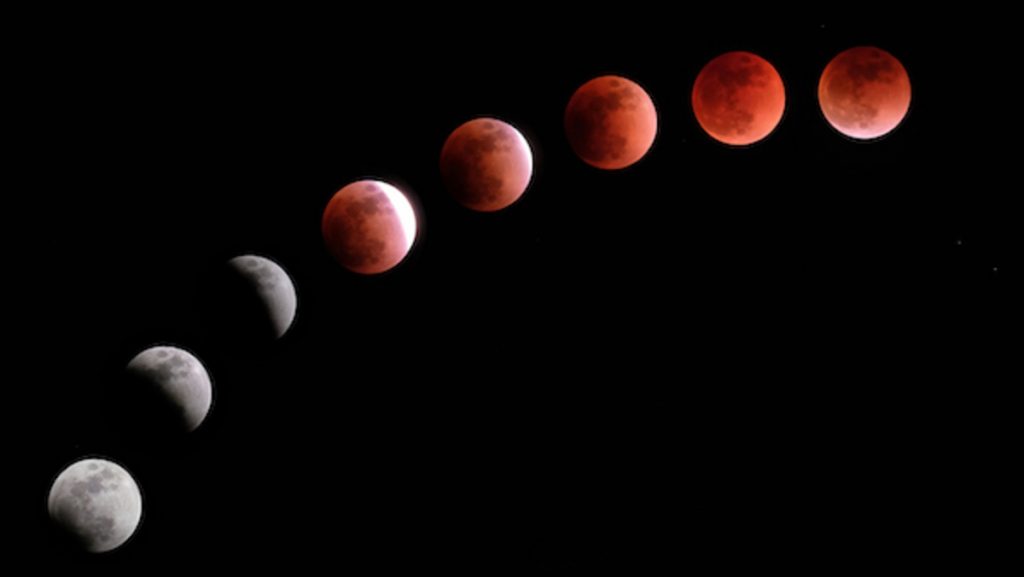Total Lunar Eclipse
By Dr. Michael Krawczynski, Assistant Professor of Earth and Planetary Sciences at Washington University, St. Louis

Eclipses are astronomical events that have fascinated human beings throughout history. These transcendent occurrences have always frightened, fascinated or inspired fantasy.
Overnight on Sunday, May 15, into the early morning hours of Monday, May 16, there will be a total lunar eclipse. The entire U.S. east of Kansas will be able to view the event, from start to finish, provided there are no clouds in the way.
What is a lunar eclipse? Lunar eclipses always occur during a full moon, but not every full moon. A full moon occurs every 27-28 days, as the moon orbits around the earth in that amount of time. Eclipses do not happen every full moon because the moon’s orbit is slightly tilted compared to the “ecliptic,” which is the plane defined by the earth orbiting the sun, and all solar and lunar eclipses happen along this line in the sky. Lunar eclipses only occur when the full moon phase coincides with the moon passing through or near the ecliptic plane. Eclipses (partial or total) happen at least twice a year, but sometimes up to five times a year. However, total eclipses are less common than that, and eclipses are only visible to portions of the planet, and they don’t always happen at convenient times.
What will I see? In the evening hours on Sunday, specifically at 9:25 p.m., the moon will start to enter the earth’s shadow. This will begin the partial phase of the total lunar eclipse. At 10:29 p.m., the moon will be totally engulfed by the earth’s shadow and will take on a dull reddish hue. At 11:11 p.m., the moon will be at maximum eclipse, in the deepest part of earth’s shadow. This is the darkest the moon will appear. Unlike solar eclipses, the moon is always visible during an eclipse, but instead of the bright full moon you will see a reddened disk, sometimes referred to colloquially as the “blood moon.” At 11:54 p.m., the moon will begin to exit the earth’s shadow. If you are doing the math, that means the total eclipse will last for almost an hour and a half. This is much different than a solar eclipse that only lasts for a few minutes.
Why is the moon red during an eclipse? One of the most eerie and striking features of a total lunar eclipse is that the moon turns a deep red. The reason the moon never goes totally dark is actually due to the earth having an atmosphere. If you were standing on the moon and observing the earth during a total lunar eclipse, you would at once see all the sunsets and sunrises happening at that moment on earth. The reddish light of the sunsets/rises on earth makes it to the surface of the moon. It is an extremely dim light. However, when the normal sunlight is blocked by earth’s shadow, this dim red color becomes visible and easy to make out with the naked eye.
What do I need to view the lunar eclipse? Unlike solar eclipses, no special equipment is necessary to safely enjoy a lunar eclipse. You can easily enjoy this view with the naked eye. Binoculars or a telescope would allow you to get a more detailed view of the moon’s surface, and can be enjoyable to use, but are not necessary. If you miss this total lunar eclipse, there will be others. The next one is November 8, but it will be a lot colder and at 4:00 a.m. The next one after that, visible in Missouri/Illinois, will be in 2025.
Clifftop, a local nonprofit organization, is focused on preserving and protecting area blufflands.
A version of this article appeared in the May 11, 2022 edition of the Republic-Times.
©2022 all content rights reserved Clifftop NFP
Comments are currently closed.
